What are technical grape varieties and which ones are the best?
Technical grape varieties are the basis of future wine. Experienced winemakers say that the best berry for producing this drink is the one with juicy, sugary pulp hidden under the skin. The juice yield of such varieties is 75–85% of the total fruit weight. In this article we will tell you about the best technical and table grape varieties, depending on the ripening period, skin color and growing region.
Technical grape varieties - what does it mean?
Technical grape varieties - this is a group of plants whose fruits are used to make wines, juices, compotes, marinades, vinegars, cognacs, production of raisins, currants.
Distinctive The peculiarity of such grapes is their high juice content (75–85%) and the looseness of the bunch. The type of final product depends on the sugar content and acidity of the berries. The higher the percentage of sugar in the peel and pulp, the more suitable the variety is for making wines and cognacs.
The appearance of the bunch and berries of technical varieties does not play a role, unlike table ones. The main value is the chemical and mechanical compositions, which depend on the biological characteristics and growing conditions culture. When planting the same grapes in different climatic and soil conditions, gardeners receive crops with different industrial purposes.
Top varieties with descriptions
Technical grape varieties Black Sea basin groups are widespread in Russia: Rkatsiteli, Saperavi.
To prepare wines, varieties of the Western European group are used: Chardonnay, Pinot Grigio, Pinotage, Riesling, etc.
Rkatsiteli
Rkatsiteli — Georgian technical grade, part of the Black Sea basin group.
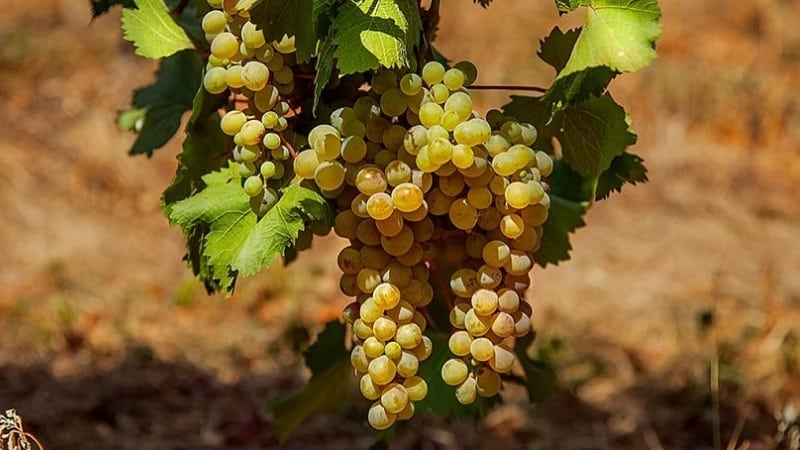
Peculiarities:
- young shoots and the first 2 leaves are pubescent gray-white, with a pink border;
- leaves are green, with a bronze tint, medium size, 3- and 5-lobed, slightly dissected;
- annual mature shoots are dark brown, with a red tint;
- flowers are bisexual;
- clusters of medium size (length - 13-15 cm, width - 7-8 cm), medium density;
- the shape of the brush is cylindrical-conical and cylindrical;
- bunch weight - 150–170 g;
- medium-sized berries (length - 15-18 cm, width - 13-14 mm), round or oval, weight - 18-25 g;
- the skin is thin but strong, golden yellow, with a bronze tan;
- the pulp is juicy, with a pleasant, unique taste;
- yield - 80–110 c/ha;
- juice yield - 80%;
- sugar content - 17.5-18 g/l, acidity - 7-9 g/l.
Grape used for making white table wines, vintage Rkatsiteli, cognac and juices.
Chardonnay
The technical variety Chardonnay comes from France (Burgundy and Champagne), popular in Germany, Hungary, Switzerland, USA, part of the group of Western European varieties.
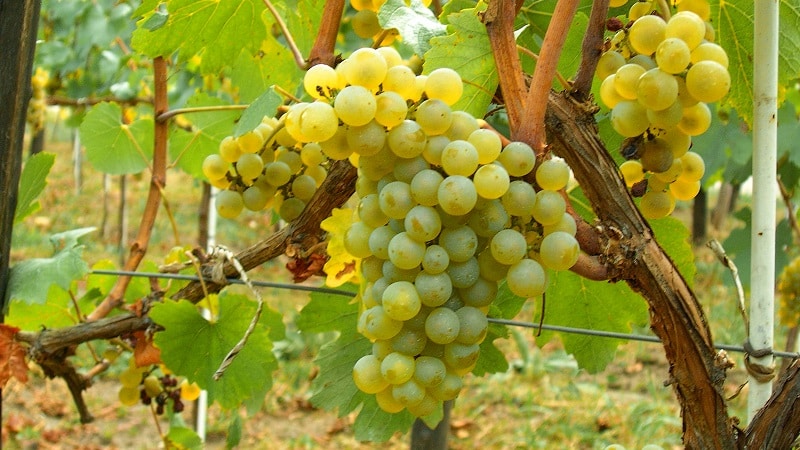
Peculiarities:
- young shoots are light green, with pinkish splashes;
- young leaves are light green with a gray tint, subsequent leaves are light green with a golden tint;
- the back side of the leaf is covered with gray cobwebs;
- the leaf blade is medium-sized, round, five-lobed;
- flowers are bisexual;
- clusters of medium size (length - 11-13 cm, width - 8-10 cm);
- the shape of the bunch is cylindrical-conical, the structure is loose or medium-dense, weight - 90–95 g;
- berries of medium size (diameter - 12–15 mm), round and slightly oval;
- the skin is thin but durable, green-white, with a golden tan, a waxy coating and brownish spots;
- berry weight - 12-13 g;
- the pulp is juicy, with a delicate aroma;
- yield - 60–70 c/ha;
- juice yield - 74%;
- sugar content – 18–23 g/100 ml, acidity – 8.2–11.6 g/l.
Chardonnay used for making white table wines with tones of lemon, apples, and vanilla, oak and smoke.
Muscadelle
Muscandel - ancient technical variety originally from France, also grown in Spain and Australia.
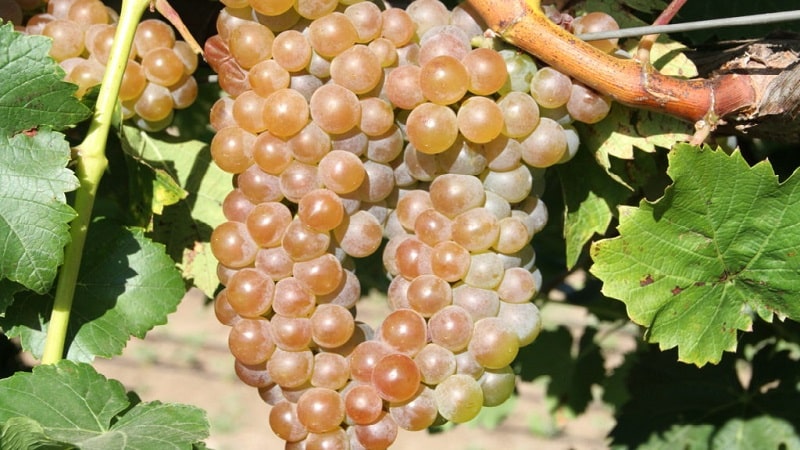
Peculiarities:
- young shoots are green-white, with a thick felt edge, annual light yellow, darker at the nodes;
- the leaf blade is medium-sized, moderately or slightly dissected, three-lobed, with sharp teeth;
- the back side of the leaf is cobwebby and bristly;
- flowers are bisexual;
- medium-sized bunch (length - 18-19 cm, width - 8-10 cm);
- the shape of the brush is winged or wide-conical, the density is medium;
- bunch weight - 100–150 g;
- berries of medium size (diameter - 10–15 mm), round, yellow-green, with a faint pink tint when overripe;
- the skin is thin, the waxy coating is weak;
- the pulp is tender and juicy, the taste is delicate nutmeg, the weight of the fruit is 13–18 g;
- yield - 30–60 c/ha;
- juice yield - 88%;
- sugar content - 22–24 g/100 ml, acidity - 8 g/l.
Harvest used for making vintage dessert wines, grape juice, fresh use.
Muscat white
Muscat white - ancient technical variety originally from Syria. Part of the group of oriental varieties, popular in Italy, France, Spain, and Bulgaria.
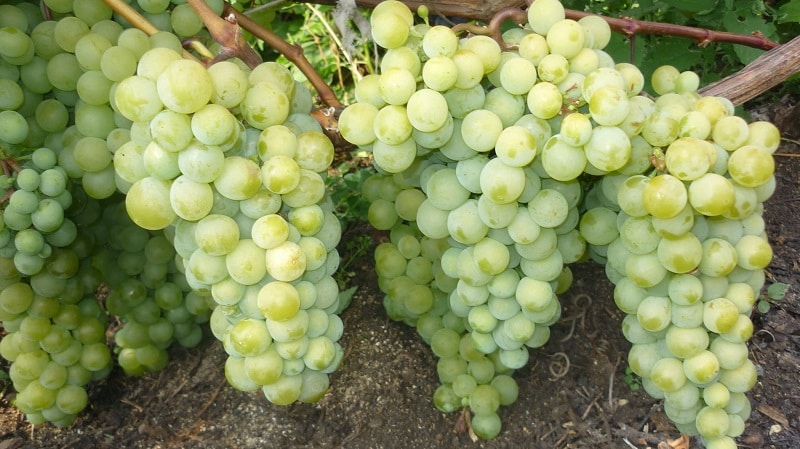
Peculiarities:
- young shoots are heavily pubescent, gray-green with a wine-red tint, ripe annual shoots are light brown, dark at the nodes;
- leaves are medium-sized, round, 3- or 5-lobed, dissected, funnel-shaped;
- the back side of the leaf is covered with cobwebby and bristly edges;
- flowers are bisexual;
- clusters of medium size (length - 13-17 cm, width - 7-9 cm);
- the shape of the bunch is cylindrical or cylindrical-conical, the structure is dense, weight - 105–450 g;
- berries of medium size (diameter - 10–17 mm), round, often deformed, yellowish-golden in color;
- medium-thick skin;
- the pulp is tender and juicy, the aroma is nutmeg, strong, there are 2-3 seeds in the berry;
- yield - 64–110 c/ha;
- juice yield - 75%;
- sugar content – 18–32 g/100 ml, acidity – 6.5–10.7 g/l.
The harvest is used for cooking:
- vintage dessert wines with a bright aroma of citron and tea rose: White Muscat Yuzhnoberezhny, Dessertny, Koktebel, Livadia, Red Stone, Magarach;
- sweet and table wines, muscat champagne;
- juices
In Italy, Asti and exquisite sparkling wines are produced under the name Moscato Bianco. In Australia, drinks are made from a dark variety of brown nutmeg.
Crystal
Crystal - Hungarian technical early ripening variety.
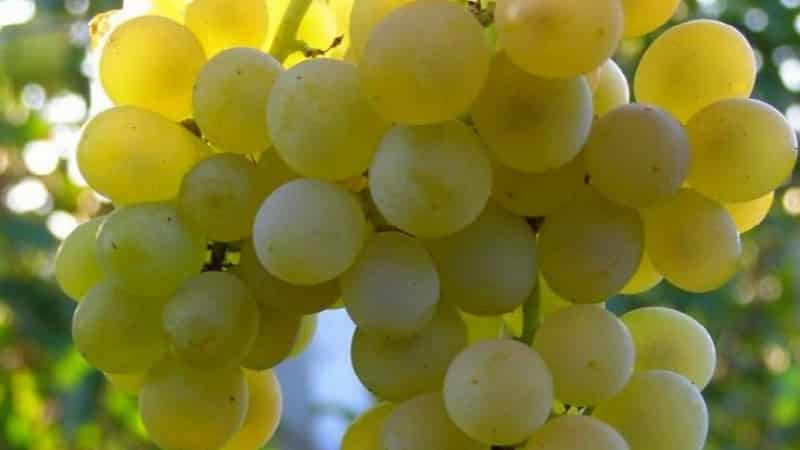
Peculiarities:
- medium-sized bushes;
- leaf blade is medium size, dark green in color;
- brushes of medium size, cylindrical-conical or conical shape, medium density, weighing 170–200 g;
- berries are medium-sized, oval-shaped, yellow-green or white with a pruin coating, weighing 1.5–2 g;
- the flesh is tender and juicy, the skin is dense;
- sugar content - 17-18%, acidity - 6-7 g/l;
- yield - 100–110 c/ha.
Berries used to make dry sherry.
Saperavi
Saperavi - an ancient variety originally from Georgia, belongs to the group plants of the Black Sea basin.
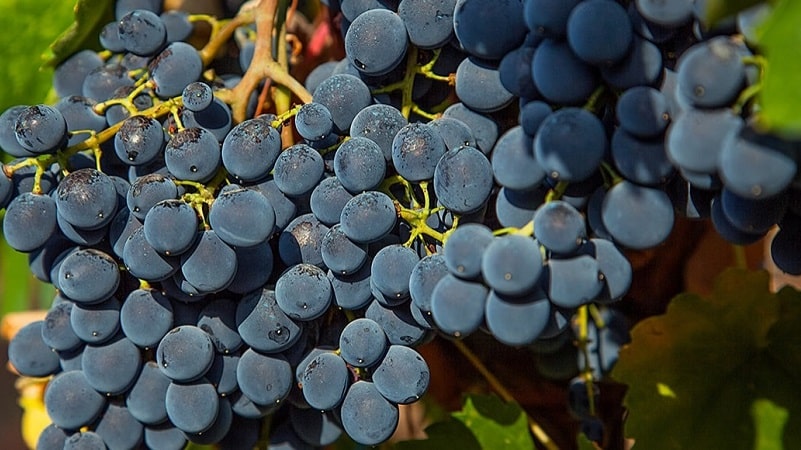
Peculiarities:
- young shoots are painted white and pink;
- young foliage is yellow-green, with a pink tint;
- annual mature shoots are light brown, with a gray tint;
- leaf blade is medium-sized, round or ovoid, 3- or 5-lobed, with raised edges;
- the back side of the sheet is covered with a thick felt edge;
- flowers are bisexual;
- bunch length – 13–17 cm, width – 12–15 cm, wide-conical loose shape;
- bunch weight - 95–100 g;
- berries of medium size (length - 12-18 mm, width - 12-17 mm), oval, weighing 120-150 g;
- the skin is thin, dark blue, covered with a thick bluish coating;
- the pulp is juicy and light;
- the taste is pleasant, refreshing;
- yield - 90–110 c/ha;
- juice yield - 80–86%;
- sugar content is 17–20 g/100 ml, acidity is 7.8–12.6 g/l, in the south of Crimea the sugar content reaches 28 g/100 ml.
Isabel
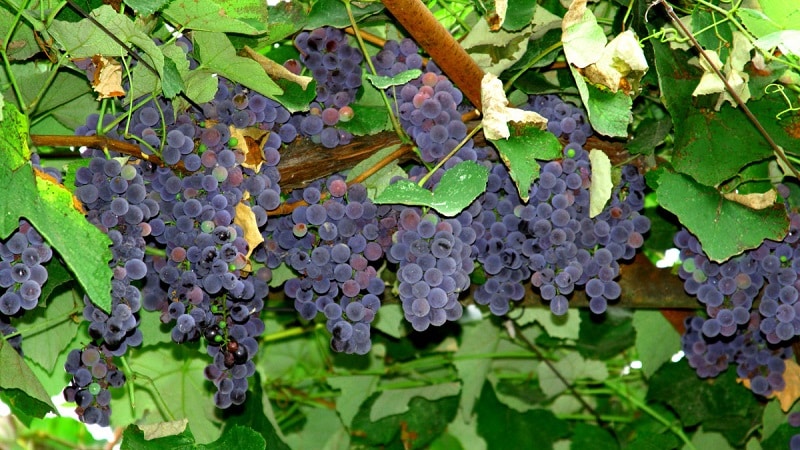
Isabella - popular table-technical variety with such characteristics:
- perennial shoots are covered with reddish, coarse-fibrous bark;
- the leaves are large, round, three-lobed or whole, the surface is smooth, the color is dark green, the back side is green-white, with dense pubescence;
- flowers are bisexual;
- yield - 13–15 c/ha;
- clusters of medium size, cylindrical or cylindrical-conical, medium-dense, less often loose;
- bunch weight - 80–300 g;
- berries are large (16x15 mm), oval, weight - 4.5–5 g;
- the skin is dense black, with a bluish coating;
- The pulp is pinkish and viscous, the taste is sweet and sour, with a rich strawberry aroma.
Isabella grapes excluded from the State Register of the Russian Federation due to non-competitiveness.
Gurzuf pink
Gurzuf pink - universal variety, characterized by early ripening.
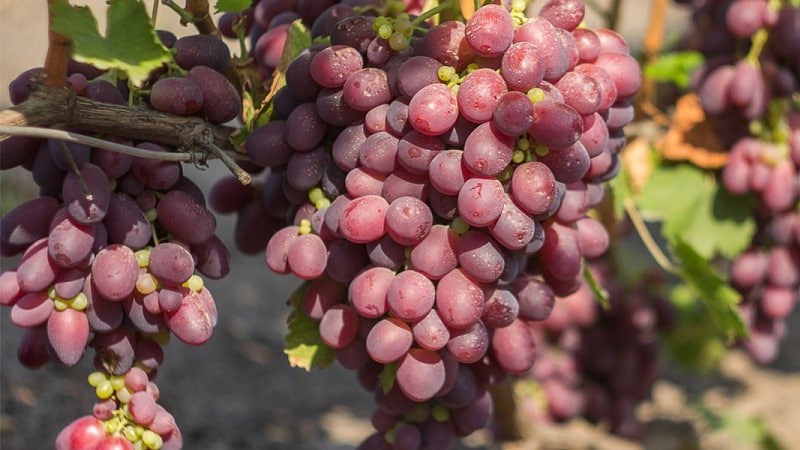
Peculiarities:
- bisexual flowers;
- clusters of medium size, cylindrical or cylindrical-conical in shape, loose structure, weighing 200–250 g;
- berries are medium, round, dark red;
- the skin is thin but dense;
- the flesh is fleshy and juicy;
- the taste is pleasant, the aroma is nutmeg;
- yield - 150 kg/ha;
- sugar content - 25.5–29%, acidity - 6-7 g/l;
- tasting score - 7.9-8 points.
Table grape varieties by ripening time
Table grapes used mainly for fresh consumption. There are plants with a ripening period of 100–110 days and ultra-early varieties, the berries of which will ripen within 3 months after bud break.
Gardeners value them for their strong immunity and early ripening. These are new hybrid forms.
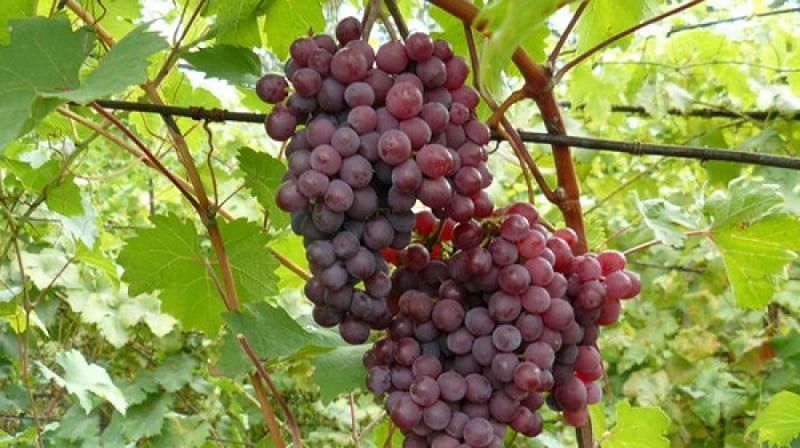
Early grapes are cultivated in the south and north of the country. It manages to gain sugar content in 3–3.5 months.
Popular early varieties and hybrids:
- Codrianca;
- Baikonur;
- Harold;
- Russian early;
- Gourmet;
- Julian;
- Alyosha;
- Tason;
- Super Extra;
- Libya;
- Elegant;
- Black cherry;
- Transfiguration;
- Aivaz;
- Beauty Seedles;
- Fun;
- Favorite;
- Arcadia;
- Bazhena;
- Hercules;
- Raspberry super;
- Rusbol.
Dining rooms mid-season varieties are grown in the southeast of the Black Earth Region, Kuban, in Crimea.
Important! In the Stavropol, Volga and central regions, such varieties need feeding, prevention of fungal infections and shelter for the winter. The harvest is harvested in September.
Popular varieties:
- Original;
- Rusmol;
- Dessert;
- Marinka;
- Autumn black;
- Crisp;
- Chocolate;
- Yalta.
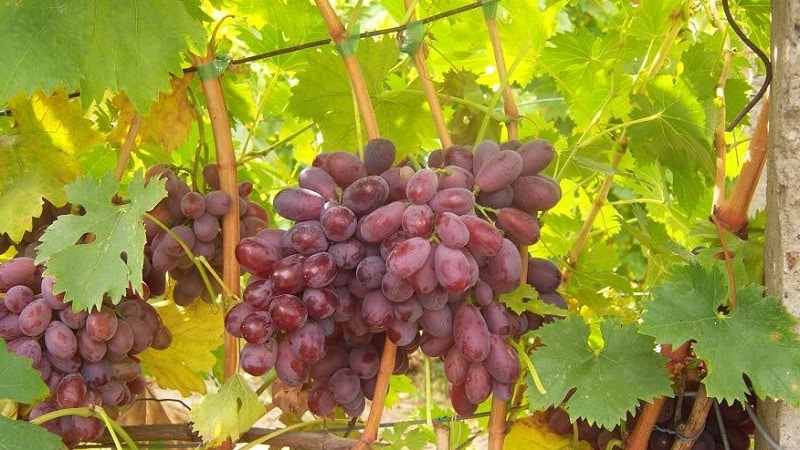
Late-ripening varieties are suitable for cultivation in the south of the country, in areas where positive temperatures at night remain until the end of November. The ripening period for such varieties is 150–165 days.
Late table grapes are grown in the Voronezh, Bryansk, Rostov, Belgorod regions, Krasnodar Territory and Crimea. Late varieties are little sensitive to frost and resistant to fungal infections.
Popular plants:
- Nimrang;
- Taifi;
- Hercules;
- Asma;
- Moldova;
- Odessa souvenir;
- Karaburn;
- Muscat is transportable;
- December;
- Winner;
- Prikubansky.
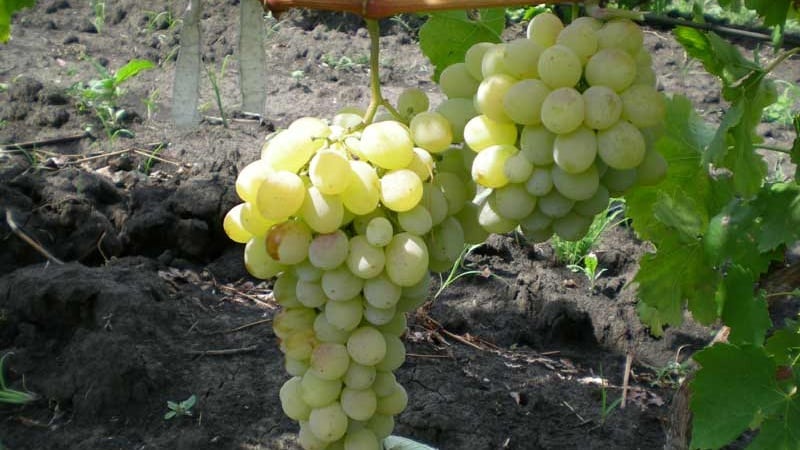
By fruit color
Table grape varieties are also distinguished by the color of the berries.
The table shows the best plants according to winegrowers and consumers:
| White | Pink | Dark |
| Augalia | Anyuta | Academician Avidzba |
| Baklanovsky | Helios | Anthracite |
| Long awaited | Gourmet Krainova | Assol |
| Kasparovsky | New Ukrainian early | Kubattik |
| Cocktail | Rochefort | In memory of the teacher |
| Russian Korinka | Alexander | Early Magaracha |
| Muscat Moscow | Arcadia | Agate Donskoy |
| Tenderness | Bashkir | Cardinal Anapa |
| Russian amber | Brigantine | Horny weed vine |
| Augustine | Neptune | Moscow black |
| Delight | Fantasy | Nadezhda AZOS |
| Larni nutmeg | Chasselas pink | Lowland |
| White early | Bogatyanovsky | Frumoasa Albe |
| Squin's firstborn | Moscow | Moldova |
| Chasselas white | Beauty of the North | Winner |
For different growing regions
When choosing table grape varieties for individual regions, gardeners pay attention to frost resistance, ripening period, drought resistance and demands on soil composition.
For Moscow region, regions Middle zone And Leningrad region plants that are resistant to frost and powdery mildew are suitable: Julian, Aleshenkin Dar, Russian Korinka, Muromets, Bogatyanovsky, Libya, Helios, Preobrazhenie, Moscow black, Tason, Tukai.
Reference. In the southern regions of the country, all known varieties of table grapes are successfully grown.
For cultivation in Siberia Early winter-hardy varieties and hybrids with a short growing season (100 days) and resistant to temperature changes are suitable: Vostorg, Rusven, Moldova, Kodryanka, Russkiy ranniy, Zagadka Sharova, Beauty of the North, Muromets.
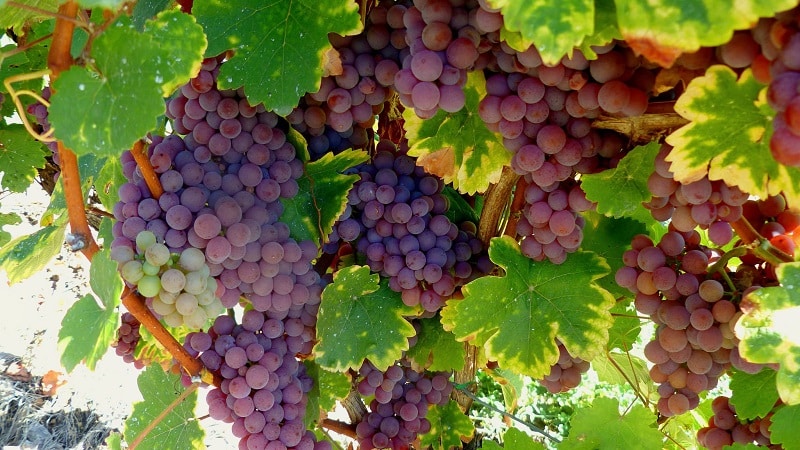
How to choose a technical grape variety
When choosing a suitable plant, it is important to consider that the same variety behaves differently in each individual region.
It all depends on the temperature regime and the composition of the soil. For example, rocky soil produces ideal grapes for the production of fine cognacs and fortified wines.
Criteria for selecting technical varieties:
- frost resistance - for the covered viticulture zone;
- the speed of vine ripening at the time of pruning (late October) determines the reliability of the variety and the success of wintering;
- ripening period - ultra-early and early varieties are suitable for the covered viticulture zone;
- resistance to diseases and pests (powdery mildew, phylloxera);
- the need for normalization affects productivity;
- taste, color, sugar content and acidity affect the taste and aroma of the final product;
- the sum of active temperatures required for the berries to fully ripen will determine the planting location.
Ancient varieties of technical grapes
Ancient varieties of technical grapes remain at the peak of popularity. They are valued for the excellent taste of berries, productivity and unique varietal aromas..
List of popular ancient varieties:
- Airen - Spanish white variety.It is distinguished by drought resistance, high growth vigor, large round berries of almost white color. The harvest is used to produce brandy, young light dry wines with notes of citrus.
- Grenache Noir - a popular Spanish grape. It is characterized by high sugar content, small round berries of a dark blue color, and is used for making fortified wines.
- Cabernet Sauvignon - an ancient French technical grape. The berries are medium in size, dark blue in color with abundant pruin, high sugar content and a nightshade flavor. The harvest is used to produce long-lasting red wines.
- Krasnostop Zolotovsky - ancient Don grapes. It is distinguished by small round berries of a dark blue color with a thick coating; it is used for the production of red table wines.
- Malbec - French technical grade. The fruits are medium in size, dark blue, almost black in color. The harvest is used to produce velvety, lively wines with a high alcohol content.
- Merlot - French technical grade. The berries are medium in size, dark blue in color, with thick pruin and colorless juicy pulp. Used for the production of table and dessert wines.
- Pinot noir - French (Burgundy) grapes. It is distinguished by rounded dark blue berries with dense pruin and juicy colorless pulp. Used to produce the famous red Burgundy wines.
- Shoulder - Donskoy mid-season variety. The berries are small, flattened, with dark blue dense skin and colorless juice. Tsimlyanskoye sparkling wine is made from it.
- Riesling - German grape variety. The fruits are round, green-white with a yellowish-brown tan.The harvest is used to produce wines with bright tones of minerals, aroma of copper and lime, and flowers.
- Tempranillo - a famous Spanish wine variety. Medium-sized berries with thin skin of dark blue color. The harvest is used to make long-lasting and high-quality wines with spicy tones.
- Shiraz (Syrah) - French old variety. It is distinguished by oval or round berries that are almost black in color. The harvest is used to produce tannic, dark, peppery wines.
In Russia, these include ancient varieties of the North Caucasus and Don. A popular grape in Italy, occupying 8% of the total vineyard area, is Sangiovese.
In New Zealand, Sauvignon Blanc is grown on 60% of the area; in France, Merlot accounts for 14% of the area. In the United States, Chardonnay and Cabernet Sauvignon are prized varieties.
Conclusion
Technical grape varieties are used for the preparation of wines, juices, compotes, marinades, vinegars, cognacs, and the production of raisins and currants. The top best varieties include Chardonnay, Rkatsiteli, Muscandel, White Muscat, Isabella, Crystal. Winemakers around the world highly value ancient wine varieties: Shiraz, Tempranillo, Riesling, Cabernet Sauvignon, Merlot, Pinot Noir. The technical grapes Plechistik and Krasnostop are grown in Russia.
Table varieties with white, pink, dark skin are used for fresh consumption. The choice of grapes depends on the climate of the region, soil composition, ripening period, taste, resistance to cold and disease.